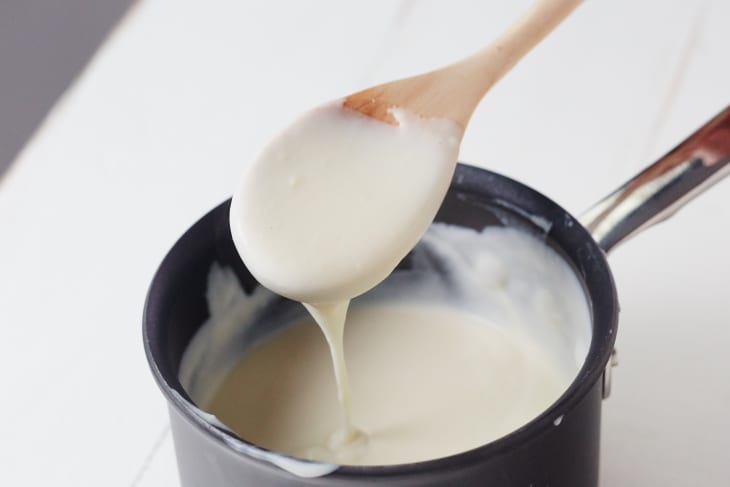If You’re Looking for Weeknight Dinner Magic, This Classic French Sauce Is Your Hero
Béchamel it. That is my command to anyone searching the depths of their refrigerator, in search of magic that doesn’t exist. Can frozen peas become dinner? Béchamel them. What can I do with chicken, cheese, and a box of pasta? A béchamel, my friends.
The creamy creation that arises from a roux (flour and fat) and whisked-in milk is too broad to define in just a sentence or two. A béchamel is one of the five mother sauces that are considered benchmarks in French cooking (the others are the velouté, béarnaise, espagnole, hollandaise, and tomato). It’s also the base for macaroni and cheese — if you know what you’re doing, at least. It’s a soup, or it can be. It’s a sauce for vegetables. It’s the most basic confluence of ingredients, and yet it provides the sturdiest, most reliable results.
How do you make a béchamel? I’m so glad you asked. In the simplest of terms it’s butter, cooked until bubbling, with flour whisked in, until a gooey, not-quite-gloppy, blond, slightly firm mass is formed. That’s a roux, a base for anything and everything. Whisk in warm-but-not-scalding milk in a slow and steady stream and, right before your eyes, you’ll see a chunk of flour and fat transform into a thick and lovely stream of cream-colored sauce. A base. A soup. A whatever. A béchamel is whatever you want it to be. It’s untapped imagination. Here are my favorite uses and tips.
Get a recipe: How To Make a Béchamel Sauce (White Sauce)
Weeknight Vegetables
Do peas feel special? I don’t know, not really. But do peas sunken in a creamy, unctuous sauce feel special? Do they ever! On a random, not-quite-spring Tuesday night, you can make peas, or corn, or tiny pearl onions from (gasp!) the freezer feel unbearably fancy with a béchamel, and you just need three ingredients (five, if you count the salt and pepper, which I don’t).
Cream of Whatever Soup
Corn, chicken, asparagus — I am the queen of transformational leftovers, and béchamel is a transformational sauce. Sauté an onion and some chopped rotisserie chicken, whip up a mother sauce, and call it dinner. I do. A silky, creamy soup needs no introduction or excuse.
Chicken Pot Pie
This dish always feels so curated when, really, it isn’t. It’s just an excuse to use up a chicken I can’t bear to throw away. Those last vestiges of Sunday’s dinner that are hanging around, the sad-looking root veggies, the dark meat no one wants? Bathe them in béchamel, toss them in a (pre-made, because this is weeknight cooking, after all) pie shell, and you have a dinner that will look more Instagram-ready than you could have imagined.
Stovetop Mac and Cheese
I hate waiting for dinner, but with a béchamel you don’t have to. Toss a handful of cheese into that perfect sauce, mix it all with your favorite shape of pasta (I’m a shell girl, myself), and you’ve got a creamy mac that doesn’t even need to see the inside of the oven.
Some Tips for Making Béchamel at Home
Can a béchamel be tricky? The answer is … sometimes. There are a few ways to avoid pitfalls, so follow my lead and you will always have a perfect mother sauce, every single time.
1. First, start with cold butter, and don’t introduce your (whisked-in) flour until it’s melted. Make sure your milk is, at the very least, room-temperature. You can heat it, slightly. Warm is good; cold is bad. If you end up with a lumpy sauce, don’t panic! You can strain your béchamel through a fine-mesh sieve once or twice to remove whatever residual flour, and that should do the trick.
2. If your sauce does not seem thick enough, give it time. The sauce won’t reach its preferred consistency until it comes to a full boil. You’ll need to simmer it over a low heat, whisking it constantly to break the barrier between the bottom of the pan and the milk solids, which are prone to burning. Once you see fat bubbles, you should notice a change in the sauce’s consistency. That’s when you can cut the heat.
3. Season your sauce. Once the sauce is thick, you can season it with salt and pepper, and, if you like, some fresh-ground nutmeg, which, although often associated with sweet foods, actually complements savory foods that the sauce is used in — especially cheese.
So take the time to master the mother of the Mother Sauces. She’s well worth the time and attention. The béchamel is the Queen of Cream. Long live the Queen!
